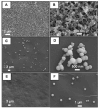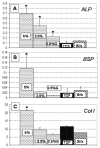Nanoscale control of silica particle formation via silk-silica fusion proteins for bone regeneration
- PMID: 20976116
- PMCID: PMC2956983
- DOI: 10.1021/cm101940u
Nanoscale control of silica particle formation via silk-silica fusion proteins for bone regeneration
Abstract
The biomimetic design of silk/silica fusion proteins was carried out, combining the self assembling domains of spider dragline silk (Nephila clavipes) and silaffin derived R5 peptide of Cylindrotheca fusiformis that is responsible for silica mineralization. Genetic engineering was used to generate the protein-based biomaterials incorporating the physical properties of both components. With genetic control over the nanodomain sizes and chemistry, as well as modification of synthetic conditions for silica formation, controlled mineralized silk films with different silica morphologies and distributions were successfully generated; generating 3D porous networks, clustered silica nanoparticles (SNPs), or single SNPs. Silk serves as the organic scaffolding to control the material stability and multiprocessing makes silk/silica biomaterials suitable for different tissue regenerative applications. The influence of these new silk-silica composite systems on osteogenesis was evaluated with human mesenchymal stem cells (hMSCs) subjected to osteogenic differentiation. hMSCs adhered, proliferated, and differentiated towards osteogenic lineages on the silk/silica films. The presence of the silica in the silk films influenced osteogenic gene expression, with the upregulation of alkaline phosphatase (ALP), bone sialoprotein (BSP), and collagen type 1 (Col 1) markers. Evidence for early bone formation as calcium deposits was observed on silk films with silica. These results indicate the potential utility of these new silk/silica systems towards bone regeneration.
Figures







Similar articles
-
Effect of the silica nanoparticle size on the osteoinduction of biomineralized silk-silica nanocomposites.Acta Biomater. 2021 Jan 15;120:203-212. doi: 10.1016/j.actbio.2020.10.043. Epub 2020 Nov 4. Acta Biomater. 2021. PMID: 33160114 Free PMC article.
-
Osteoinductive silk-silica composite biomaterials for bone regeneration.Biomaterials. 2010 Dec;31(34):8902-10. doi: 10.1016/j.biomaterials.2010.07.109. Biomaterials. 2010. PMID: 20817293 Free PMC article.
-
Influence of silk-silica fusion protein design on silica condensation in vitro and cellular calcification.RSC Adv. 2016 Jan 1;6(26):21776-21788. doi: 10.1039/C6RA03706B. Epub 2016 Feb 17. RSC Adv. 2016. PMID: 26989487 Free PMC article.
-
Osteogenic signaling on silk-based matrices.Biomaterials. 2016 Aug;97:133-53. doi: 10.1016/j.biomaterials.2016.04.020. Epub 2016 Apr 26. Biomaterials. 2016. PMID: 27163625 Review.
-
Silk scaffolds in bone tissue engineering: An overview.Acta Biomater. 2017 Nov;63:1-17. doi: 10.1016/j.actbio.2017.09.027. Epub 2017 Sep 20. Acta Biomater. 2017. PMID: 28941652 Review.
Cited by
-
Biomedical applications of solid-binding peptides and proteins.Mater Today Bio. 2023 Feb 15;19:100580. doi: 10.1016/j.mtbio.2023.100580. eCollection 2023 Apr. Mater Today Bio. 2023. PMID: 36846310 Free PMC article. Review.
-
Purification and cytotoxicity of tag-free bioengineered spider silk proteins.J Biomed Mater Res A. 2013 Feb;101(2):456-64. doi: 10.1002/jbm.a.34353. Epub 2012 Aug 3. J Biomed Mater Res A. 2013. PMID: 22865581 Free PMC article.
-
Structure-function-property-design interplay in biopolymers: spider silk.Acta Biomater. 2014 Apr;10(4):1612-26. doi: 10.1016/j.actbio.2013.08.020. Epub 2013 Aug 17. Acta Biomater. 2014. PMID: 23962644 Free PMC article. Review.
-
Biomineralization of Engineered Spider Silk Protein-Based Composite Materials for Bone Tissue Engineering.Materials (Basel). 2016 Jul 11;9(7):560. doi: 10.3390/ma9070560. Materials (Basel). 2016. PMID: 28773681 Free PMC article.
-
Recent Advances in Development of Functional Spider Silk-Based Hybrid Materials.Front Chem. 2020 Jun 30;8:554. doi: 10.3389/fchem.2020.00554. eCollection 2020. Front Chem. 2020. PMID: 32695749 Free PMC article. Review.
References
-
- Sakiyama-Elbert SE, Hubbell JA. Annu Rev Mater Res. 2001;31:183–201.
-
- Tan W, W K, He X, Zhao XJ, Drake T, Wang L, Bagwe RP. Med Res Rev. 2004;24:621–638. - PubMed
-
- Coradin T, Livage J. Acc Chem Res. 2007;40:819–826. - PubMed
-
- Neaton JB, M DA, Ashcroft NW. Phys Rev Lett. 2000;85:1298–1301. - PubMed
-
- Kilian KA, B T, Gooding J. J Chem Commun. 2009;6:630–640. - PubMed
Grants and funding
LinkOut - more resources
Full Text Sources
